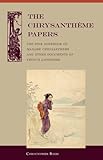The Chrysantheme Papers : The Pink Notebook of Madame Chrysantheme and other Documents of French Japonisme / Christopher Reed, Félix Régamey.
Material type: TextPublisher: Honolulu : University of Hawaii Press, [2010]Copyright date: ©2010Description: 1 online resource (176 p.)Content type:
TextPublisher: Honolulu : University of Hawaii Press, [2010]Copyright date: ©2010Description: 1 online resource (176 p.)Content type: - 9780824833459
- 9780824860721
- 400
- PQ1139.J36 ǂb C57 2010eb
- online - DeGruyter
- Issued also in print.
| Item type | Current library | Call number | URL | Status | Notes | Barcode | |
|---|---|---|---|---|---|---|---|
 eBook
eBook
|
Biblioteca "Angelicum" Pont. Univ. S.Tommaso d'Aquino Nuvola online | online - DeGruyter (Browse shelf(Opens below)) | Online access | Not for loan (Accesso limitato) | Accesso per gli utenti autorizzati / Access for authorized users | (dgr)9780824860721 |
Frontmatter -- Contents -- Acknowledgments -- Introduction -- Part I. The Pink Notebook of Madame Chrysanthème -- The Pink Notebook of Madame Chrysanthème -- Notes on the Translation -- Le Cahier Rose de Madame Chrysanthème -- Part II. Selections from Madame Chrysanthème, Pierre Loti, and Walks through Japan, Emile Guimet -- Introductory Note -- Madame Chrysanthème -- Madame Chrysanthème -- Walks through Japan -- Promenades Japonaises -- Index -- About the Translator
restricted access online access with authorization star
http://purl.org/coar/access_right/c_16ec
Pierre Loti's novel Madame Chrysanthème (1888) enjoyed great popularity during the author's lifetime, served as a source of Puccini's opera Madama Butterfly, and remains in print to this day as a classic in Western literature. Loti's story, cast in the form of his fictionalized diary, describes the affair between a French naval officer and Chrysanthème, a temporary "bride" purchased in Nagasaki. More broadly, Loti's novel helped define the terms in which Occidentals perceived Japan as delicate, feminine, and, to use one of Loti's favorite words, "preposterous"-in short, ripe for exploitation. The Pink Notebook of Madame Chrysanthème (1893) sought, according to a newspaper reviewer at the time, "to avenge Japan for the adjectives that Pierre Loti has inflicted on it." Written by Félix Régamey, a talented illustrator with firsthand knowledge of Japan, The Pink Notebook retells Loti's story but this time as the diary of Chrysanthème. The book, presented here in English for the first time and together with the original French text and illustrations by Régamey and others, is certainly surprising in its late nineteenth-century context. Its retelling of a classic tale from the position of a character marginalized by her sex and race provocatively anticipates certain aspects of postmodern literature. Translator Christopher Reed's rich and satisfying introduction compares Loti and Régamey in relation to attitudes toward Japan held by notable Japonistes Vincent van Gogh, Lafcadio Hearn, Edmond de Goncourt, and Philippe Burty. Reed provides further intellectual context by including new translations of excerpts from Loti's novel as well as a portion of the travel journal of Régamey's travel companion, the renowned collector Emile Guimet. Reed's emphasis on competing Western ideas about Japan challenges conventional scholarly generalizations concerning Japanism in this era. This elegant translation of The Pink Notebook and Japoniste documents will delight both general and specialized readers, particularly those interested in the ambiguities in the dynamics of nationalism, gender, identification, and exploitation that, since the nineteenth century, have characterized the West's relationship to Japan.
Issued also in print.
Mode of access: Internet via World Wide Web.
In English.
Description based on online resource; title from PDF title page (publisher's Web site, viewed 02. Mrz 2022)


